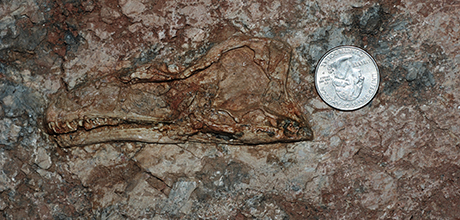A George Washington University professor has found and identified a new species of a meat-eating dinosaur in northwestern China.
The 2006 discovery of the fossil remains--a skull, mandible and partial skeleton--was made in a remote region in Xinjiang in China by James Clark, the Ronald B. Weintraub Professor of Biology for the Columbian College of Arts and Sciences, and then-doctoral student Jonah Choiniere, along with a team of international researchers.
“All that was exposed on the surface was a bit of the leg,” Dr. Clark said. “We were pleasantly surprised to find a skull buried in the rock too.”
Drs. Clark and Choiniere outlined their discovery in a new paper published in the Journal of Systematic Palaeontology. They write that the dinosaur--named Aorun zhaoi after the Dragon King in the Chinese epic tale “Journey to the West”--was likely five feet long and probably weighed about 3.3 pounds. That doesn’t mean it was a small species, however, as the dinosaur became fossilized at a young age.
“We were able to look at microscopic details of Aorun’s bones and they showed that the animal was less than a year old when it died on the banks of a stream,” said Dr. Choiniere, now a senior researcher at the Evolutionary Studies Institute at the University of the Witwatersrand in Johannesburg, South Africa.
The dinosaur dates back to more than 161 million years ago--the earliest part of the Late Jurassic Period. Its small, numerous teeth suggest that it would have eaten prey like lizards and small relatives of today’s mammals and crocodilians.
The National Science Foundation Division of Earth Sciences and the Chinese National Natural Science Foundation funded the research.


